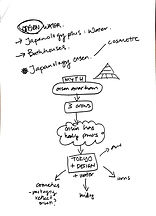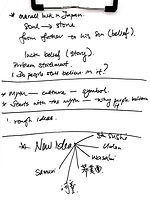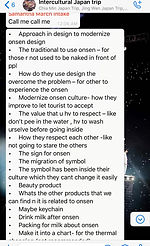intercultural design
06/01/20 - 30/01/20 (Week 1 - Week 4)
phang shuen (0333804)
Intercultural Design
Project 1 : Proposal
On the first lecture, we are required to form a group of four with a mixture of different people from a different module. Then, Mr Charles brief us on the importance of how can a culture reflect the image of a country. Thus, our mission for the next tutorial is to find myths that strongly believe by the citizens of Japan and came out with a topic proposal. Our final product is required to interpret the myths that we research.
On the first tutorial, we came out a few ideas.
-
Different kind of chopsticks
-
Harajuku Fashion
-
Yami Kawaii
-
Samurai inspired clothing
-
Pornography
Some of our ideas were rejected as we are not finding anything that is related to its myth so we have to do more background research related to myth and its origin
Comment Get:
-
Some of our topics are sub-culture. Sub-culture goes against myth for example, we need to drop Harajuku fashion and Yami Kawai.
-
Ms Anis and Mr Asrrizal recommended us to focus on Onsen and Magatama considering they're more interesting topics while also continuing our research for chopsticks to see if it's a workable topic.
-
Think of other topics and present another 5 topics during our next consultation with Ms Anis.
On week 2 tutorial, we showcase to file. We first put all our research into doc then only select highlighted points and put it into a visual presentation slide.
Our ideas have slightly changed.
-
Onsen
-
Magatama
-
Utensils
-
Kimono
-
Furoshiki
We have too much of distraction between too many ideas, thus we decided to choose only research on Onsen and Magatama as other ideas of ours originally are not from Japan.
Comment Get:
-
The direction of our group isn't really clear so Ms Anis helped us trying to explain to us how to make use of our topic to research more.
-
Chopstick's origin is mainly related to Chiana. In the slides, we mentioned about Confucius and it is more on historical facts while myth cames with no scientific research.
-
We should think of one more extra topic to make 3 topics in total so we have 2 backups.
Before our presentation of our topic proposal, we get the opinion of being too focused on just onsen and magatama while not research the base essence of it. Therefore, we are back into its basic - the element water and the lucky charms.
After the deep research, we realise that Tokyo itself was built on water and it was now forgotten by people while onsen culture still stands strong in Japan. Furthermore, there is a lot of other lucky charms besides magatama. from this, we realise japan is a country that very much focuses on charms.
With all those research we also came out a few of the ideation of our final outcome. then we compose it into a presentation slide.
Then we came out research question for our proposal for us to do research we travel to Japan.
-
Is onsen more than just bath? Does it also play important roles in HEALING and Socialising?
-
Is there any special artefacts and products related to onsen that only available for Japanese only?
-
Are the citizen of Japanese really willing to promote the culture of Onsen and what is their opinion on the future development of Onsen based on design?



Note from Ms Annis


Note summarize by Samantha
03/02/20 - 19/02/20 (Week 5 - Week 7)
Intercultural Design
Project 2
On week 4, our Japan trip begins (03/02/20 - 10/02/20)
Considering our topic was onsen and magatama, we decided to visit Odaiba's Onsen for our research and try searching for signs of Magatama in Japanese everyday life to help find some answers for our research questions. However, we couldn't find various signs of Magatama so we took a lot of pictures of other lucky elements instead.
For Onsen, we experience fully in order to let ourself immerse into the atmosphere of healing. We took a lot of photos and video to make it a vlog.

Once we return from Japan, we started compiling everything into a presentation slide.
After showing our slides to Ms Anis on 13/02/20, Ms Anis said that it was good but we should :
-
Seperating the healing properties of onsen differently according
-
Rephrase some of our text,
-
Decide if we want to combine our two topics or choose just one for our final project, and
-
To write our self- reflecton
We then present on February 17.
17/02/20 - 03/03/20 (Week 7 - Week 9)
Intercultural Design
Project 3
After the data collection, we realise that the importance of understanding a culture can highly affect the future development of the particular development.
With this concept, we make use of the culture- drinking milk after onsen which rarely known by foreigners to promote this culture and at the same time also let people realise the holiness of onsen can be.
We wanted to promote it correctly. Making use of the packaging of the milk cartoon.
Week 8 (24/02/20)
24/02/20 (Day 0)
We showed Ms Anis the slides and presented our ideas.
Feedbacks:
-
Wants us to just focus on one set and make it collectable.
-
Likes the idea of having one part of the packaging be transparent, making it interactive.
-
To decide if we were to work with an existing milk company or creating our own brand.
-
If we're creating our own, she hopes that the brand name could be easily remembered and maybe we could work on wordplay.
25/02/20 (Day 1)
Discussing Brand name.
After coming out with all sort of weird name which we wanted to rhym with milk, zen, healing and water, we finally decide to use the name MISURU.
Our brand name, Misuru (ミすル), is a combination of Mi(未) and suru(する).We want to impose that our brand will help you finish off your onsen experience with a refreshing and hydrated note. However, we changed the 未 to ミ and る to ル since milk in Japanese is written as ミルク (miruku). Another reason we choose "Misuru" as the brand name is because we think it rhymes with miruku and also susu, which means milk in Bahasa Malaysia.
26/01/20 (Day 2)
Discussing Graphics.
Our finalise design concept was to be more minimalistic so the graphics would be easier to understand. We would include different seasons to show that there are different types of Onsen which would tie well with us showing the milk through the transparent layer and also because Onsen is a bath that people can visit in any season. Buildings from the Edo Period can be added as we wanted to show that the Onsen we went to was heavily inspired by Edo Period architecture. Then finally, Samantha sketches out the movement of a hurting heron to a recover heron. We then discuss the colour scheme too.
27/02/20 - 28/02/20 (Day 3-Day 4)
Drawing Graphic & Making Test Model
After drafting out, we then use a milk template then starting to use illustrator to draw the graphic we wanted. Some of the members work on logo and font while some work on the illustration needed to draw. We also did a custom nutrition facts. Jing Wen continues to help us in the background. Then continue to the second day, we printed out the templet to do a test model to test is it foldable.
29/02/20 (Day 5)
Printing Day.
On this day, we make some slight changes to the colours, then we when to a printing shop to print out the milk carton.
then we cut out the unwanted part and assemble it.
then we make a rationale and a presentation slide to present our product well.




_edited.jpg)




















